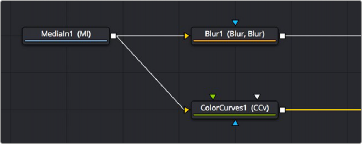
< Previous | Contents | Next >
Identifying Node Inputs and Node Outputs
Each node displays small colored connections around the edges. One or more arrows represent inputs, and the square connection represents the tool’s processed output, of which there is always only one. If you hover the pointer over any of a node’s inputs or output, the name of that input or output immediately appears in the Status bar. If you wait for a few more moments, a floating tooltip displays the same name right over the node.
Node Editing Essentials
Each node has inputs and outputs that are “wired together” using connections. The inputs are represented by arrows that indicate the flow of image data from one node to the next, as each node applies its effect and feeds the result (via the square output) to the next node in the tree. In this way, you can quickly build complex results from a series of relatively simple operations.

Three nodes connected together
You can connect a single node’s output to the inputs of multiple nodes (called “branching”).

![]()
One node branching to two to split the image to two operations
You can then composite images together by connecting the output from multiple nodes to certain nodes such as the Merge node that combines multiple inputs into a single output.

Two nodes being merged together into one to create a composite